Pistacia lentiscus: Phytochemistry and Antidiabetic Properties
Abstract
1. Introduction
2. Chemical Constituents
2.1. Terpenoids (1–75)
2.2. Phenolic Compounds (76–136)
2.2.1. Flavonoids (100–126)
2.2.2. Tannins (127–136)
2.3. Fatty Acids (137–144)
2.4. Steroids (145–148)
3. Antidiabetic Properties
3.1. In Vitro Experiments
3.1.1. α-glucosidase and α-amylase Inhibition
3.1.2. Inhibition of Lipase
3.1.3. Inhibition of 11β-Hydroxysteroid Dehydrogenase 1
3.1.4. Biological Activity towards PPARγ
3.2. In Vivo Experiments
3.2.1. Hypoglycemic Effect
Mice Models
Human Models
3.2.2. Hypolipidemic Effect
Mice Models
Rabbit Models
Human Models
| Antidiabetic Activity | ||||||
|---|---|---|---|---|---|---|
| Plant Part | Origin | Type of Extract/ Active Compounds | Compound | Results | Ref. | |
| Leaves | Algeria | Methanolic | Gallic acid (85) Vanillic acid (86) p-Coumaric acid (91) Caffeic acid (92) | Inhibition of pancreatic lipase (IC50 = 2.8 μg/mL) Inhibition of α-amylase (IC50 = 5.81 mg/mL) and sucrase (IC50 = 9.32 mg/mL). Increase in glucose transport across the yeast cell membrane | In vitro | [23,33] |
| Hypoglycemic effect: reduction in blood glucose level and increase in insulin level | In vivo (Rat) | |||||
| Leaves | Algeria | Aqueous and ethanolic | n.r. | Hypolipidemic effect: reduction in triglycerides, total cholesterol and LDL-cholesterol levels | In vivo (Mice) | [42] |
| Leaves | Italy (Sardinia) | Aqueous | Myricetin (105) Quercetin-3-O-rutinoside (rutin) (106) Quercetin 3-O-glucoside (107) Myricetin 3-O-rhamnoside (113) Myricetin 3-O-rutinoside (116) Quercetin-3,4’-diglucoside (118) Quercetin-3-O-galactoside (119) Myricetin-3-O-arabinopyranoside (120) Myricetin-3-O-xylopyranoside (121) | Decreases in enzymatic starch hydrolysis (IC50 = 65.3 μg/mL for leaf and IC50 = 1.4 mg/mL for fruit extract) Inhibition of pancreatic lipase (IC50 = 6.1 μg/mL for leaf and IC50 = 230.7 μg/mL for fruit extract) | In vitro | [22] |
| Fruits | Gallic acid (85) Quercetin-3-O-rutinoside (rutin) (106) Quercetin 3-O-glucoside (107) Myricetin 3-O-glucoside (112) Luteolin-3’-O-glucoside (117) 3,5-Digalloyl quinic acid (129) 3-Galloyl quinic acid (131) 5-Galloyl quinic acid (132) 1,5-Digalloyl quinic acid (136) | |||||
| Fruits | Morocco | Essential oils | α-Pinene (1) (R) Limonene (3) (S) Limonene (10) | Inhibition of α-amylase (IC50 = 112.35 μg/mL for essential oils, IC50 = 82.12 μg/mL for α-pinene and IC50 = 74.39 μg/mL for limonene) Inhibition of α-glucosidase (IC50 = 116.03 μg/mL for essential oils, IC50 = 95.62 μg/mL for α-pinene and IC50 = 78.03 μg/mL for limonene) | In vitro | [19] |
| Leaves Fruits | Algeria | Ethanolic | Salicylic acid (84) Gallic acid (85) Syringic acid (88) 3,4-Dihydroxyhydro-cinnamic acid (94) Ellagic acid (95) Luteolin (100) Catechin (102) Quercetin 3-O-rhamnoside (114) | Inhibition of α-amylase (IC50 = 87.5 μg/mL for leaf and IC50 = 144.29 μg/mL for fruit extract). | In vitro | [24] |
| Hypoglycemic effect: reduction in blood glucose level | In vivo (Mice) | |||||
| Leaves Stem barks Fruits | Algeria | Methanolic | Epigallocatechin(4a > 8)epigallocatechin (122) 3,5-Digalloyl quinic acid (129) (Epi)gallocatechin-3-O-galloyl-(Epi)gallocatechin (123) β-Glucogallin (128) | Inhibition of α-glucosidase (IC50 = 5.8 μg/mL for littoral and IC50 = 7.9 μg/mL for mountain stem bark extract) | In vitro | [1,2] |
| Black fruits | Algeria | Deep Eutectic Solvent (DES) | Catechol (78) Gallic acid (85) Cinnamic acid (90) Coumaric acid (91) Caffeic acid (92) Kaempferol (101) Catechin (102) Quercetin (103) Rutin (106) Cyanidin-3-O-glucoside (109) Chrysin (124) Silymarin (125) Deosmin (126) Ascorbic acid (154) Citric acid (155) Tartaric acid (156) Curcumin (157) 3,5-Dimethoxy-4-hydroxy-tannic acid (134) Tannic acid (135) | Inhibition of α-amylase | In vitro | [21] |
| Black fruits | Algeria | Fatty oil (PLFO) and unsaponifiable matter (USM) | n.r. | Inhibition of α-amylase (IC50 > 400 μg/mL for PLFO and IC50 = 180.93 μg/mL for USM) Inhibition of α-glucosidase (IC50 = 163.47 μg/mL for PLFO and IC50 = 155.77 μg/mL for USM) | In vitro | [28] |
| Chios mastic gum | n.r. | Oleoresin and its neutral and acidic fraction/oleanoic acid | Oleanoic acid (51) | PPARγ agonists | In vitro Virtual screening | [37] |
| Chios mastic gum | n.r. | Oleoresin and its acidic fraction/masticadienonic and isomasticadienonic acid | 28-Norolean-17-en-3-one (45) Isomasticadienonic acid (49) Masticadienonic acid (50) Oleanolic acid (51) Masticadienolic acid (70) 3-Epimasticadienolic acid (74) Methyl 3-epimasticadienolate (75) | Inhibition of 11β-HSD1 (IC50 = 1.33 μg/mL for oleoresin, IC50 = 2.10 μg/mL for acidic fraction, IC50 = 2.51 μg/mL for masticadienonic acid IC50 = 1.94 μg/mL for isomasticadienonic acid) | In vitro Virtual screening | [35] |
| Chios mastic gum | Italia | Supermastic | Oleanonic acid (46) Moronic acid (47) Maslinic acid (48) Isomasticadienonic acid (49) Masticadienonic acid (50) Oleanolic acid (51) Masticadienolic acid (70) Isomasticadienolic acid (71) | Inhibition of disaccharidase activity in Caco-2 cells Reduction in sucrase-isomaltase expression | In vitro | [30] |
| Chios mastic gum | Pakistan | Crude gum powder | n.r. | Hypoglycemic effect: reduction in blood glucose level | In vivo (Rat) | [40] |
| Chios mastic gum | Greece | Crude gum | n.r. | Hypoglycemic and hypolipidemic effect: reduction in blood glucose level and reduction in serum triglyceride, total cholesterol and LDL levels | In vivo (Mice) | [43] |
| Chios mastic gum | Greece | Total mastic extract without polymer | 28-Norolean-17-en-3-one (45) Oleanoic acid (46) Moronic acid (47) 24Z-Isomasticadienoic acid (49) 24Z-Masticadienoic acid (50) Olean-12,18-dien-3-olic acid (72) | Hypolipidemic effect: reduction in total cholesterol and LDL circulatory levels | In vivo (Rabbit) | [44] |
| Neutral mastic fraction | Butyrospermol (55) Oleanolic aldehyde (57) β-Amyrone (59) Betulonal (61) Tirucallol (63) Dammaradienone (64) | |||||
| Fruits | Algeria | Fatty oil | Oleic acid (138) Linoleic acid (140) Palmitic acid (142) | Anti-hyperlipidemic effect: reduction in total cholesterol, LDL-cholesterol and triglyceride levels | In vivo (Rabbit) | [29] |
| Chios mastic gum | Greece | Crude gum powder | n.r. | Hypoglycemic and hypolipidemic effect: reduction in blood glucose and total cholesterol level | In vivo (Human) | [20] |
| Chios mastic gum | Japan | Capsules of gum powder | Camphene (7) Verbenone (15) Linalool (39) α-Terpinolene (42) 28-Norolean-17-en-3-one (45) Moronic acid (47) Masticadienonic acid (50) Oleanolic acid (51) Oleanolic aldehyde (57) β-Amyrone (59) Tirucallol (63) Dammaradienone (64) Masticadienolic acid (70) Isomasticadienolic acid (71) Isomasticadienolic aldehyde (73) | Hypoglycemic and hypolipidemic effect: reduction in insuline resistence and reduction in serum triglycerides | In vivo (Human) | [41] |
| Chios mastic gum | n.r. | Mastic solution | n.r. | Hypoglycemic and hypolipidemic effect: reduction in blood glucose level and total cholesterol, LDL, total cholesterol/HDL ratio | In vivo (Human) | [46] |
| Chios mastic gum | n.r. | Essential oils in gel capsules | α-Pinene (1) β-Pinene (2) (R) Limonene (3) β-Mircene (4) Camphene (7) (−) β-Caryophyllene (28) (+) β-Caryophyllene (29) α-Thujene (43) o-Methylanisol (153) | Hypolipidemic and anti-obesity effect: reduction in triglycerides and LDL | In vivo (Human) | [45] |
4. Conclusions and Future Directions
Author Contributions
Funding
Conflicts of Interest
References
- Sehaki, C.; Molinie, R.; Mathiron, D.; Fontaine, J.X.; Jullian, N.; Ayati, F.; Fernane, F.; Gontier, E. Metabolomics-Based Profiling via a Chemometric Approach to Investigate the Antidiabetic Property of Different Parts and Origins of Pistacia Lentiscus L. Metabolites 2023, 13, 275. [Google Scholar] [CrossRef]
- Dragović, S.; Dragović-Uzelac, V.; Pedisić, S.; Čošić, Z.; Friščić, M.; Garofulić, I.E.; Zorić, Z. The Mastic Tree (Pistacia Lentiscus l.) Leaves as Source of BACs: Effect of Growing Location, Phenological Stage and Extraction Solvent on Phenolic Content. Food Technol. Biotechnol. 2020, 58, 303–313. [Google Scholar] [CrossRef] [PubMed]
- Piccolella, S.; Nocera, P.; Carillo, P.; Woodrow, P.; Greco, V.; Manti, L.; Fiorentino, A.; Pacifico, S. An Apolar Pistacia Lentiscus L. Leaf Extract: GC-MS Metabolic Profiling and Evaluation of Cytotoxicity and Apoptosis Inducing Effects on SH-SY5Y and SK-N-BE(2)C Cell Lines. Food Chem. Toxicol. 2016, 95, 64–74. [Google Scholar] [CrossRef] [PubMed]
- Ierapetritis, D.G. The Geography of the Chios Mastic Trade from the 17th through to the 19th Century. Ethnobot. Res. Appl. 2010, 8, 153–167. [Google Scholar] [CrossRef]
- Pachi, V.K.; Mikropoulou, E.V.; Gkiouvetidis, P.; Siafakas, K.; Argyropoulou, A.; Angelis, A.; Mitakou, S.; Halabalaki, M. Traditional Uses, Phytochemistry and Pharmacology of Chios Mastic Gum (Pistacia Lentiscus Var. Chia, Anacardiaceae): A Review. J. Ethnopharmacol. 2020, 254, 112485. [Google Scholar] [CrossRef] [PubMed]
- Soulaidopoulos, S.; Tsiogka, A.; Chrysohoou, C.; Lazarou, E.; Aznaouridis, K.; Doundoulakis, I.; Tyrovola, D.; Tousoulis, D.; Tsioufis, K.; Vlachopoulos, C.; et al. Overview of Chios Mastic Gum (Pistacia Lentiscus) Effects on Human Health. Nutrients 2022, 14, 590. [Google Scholar] [CrossRef] [PubMed]
- Janakat, S.; Al-Merie, H. Evaluation of Hepatoprotective Effect of Pistacia Lentiscus, Phillyrea Latifolia and Nicotiana Glauca. J. Ethnopharmacol. 2002, 83, 135–138. [Google Scholar] [CrossRef] [PubMed]
- Saeedi, P.; Petersohn, I.; Salpea, P.; Malanda, B.; Karuranga, S.; Unwin, N.; Colagiuri, S.; Guariguata, L.; Motala, A.A.; Ogurtsova, K.; et al. Global and Regional Diabetes Prevalence Estimates for 2019 and Projections for 2030 and 2045: Results from the International Diabetes Federation Diabetes Atlas, 9th Edition. Diabetes Res. Clin. Pract 2019, 157, 107843. [Google Scholar] [CrossRef] [PubMed]
- Tripathi, B.K.; Srivastava, A.K. Diabetes Mellitus: Complications and Therapeutics. Med. Sci. Monit. 2006, 12, RA130-47. [Google Scholar]
- Dirir, A.M.; Daou, M.; Yousef, A.F.; Yousef, L.F. A Review of Alpha-Glucosidase Inhibitors from Plants as Potential Candidates for the Treatment of Type-2 Diabetes. Phytochem. Rev. 2021, 21, 1049–1079. [Google Scholar] [CrossRef]
- Fan, W. Epidemiology in Diabetes Mellitus and Cardiovascular Disease. Cardiovasc. Endocrinol. 2017, 6, 8–16. [Google Scholar] [CrossRef] [PubMed]
- Aziz, K.M.A. Management of Type-1 and Type-2 Diabetes by Insulin Injections in Diabetology Clinics—A Scientific Research Review. Recent Pat. Endocr. Metab. Immune Drug Discov. 2012, 6, 148–170. [Google Scholar] [CrossRef]
- Banu, S.; Bhowmick, A. Therapeutic Targets of Type 2 Diabetes: An Overview. MOJ Drug Des. Dev. Ther. 2017, 1, 11. [Google Scholar] [CrossRef]
- El-Amir, M.; Hegazy, F.; Pare, P.W.; Ibrahim, M.A.A.; Najmi, A.; Javed, S.A.; Al Bratty, M.; Alhazmi, H.A. Modern Approaches in the Discovery and Development of Plant-Based Natural Products and Their Analogues as Potential Therapeutic Agents. Molecules 2022, 27, 349. [Google Scholar] [CrossRef]
- Pham Ngoc, L.; Man, H.-y.; Besselink, H.; Dang Thi Cam, H.; Brouwer, A.; van der Burg, B. Identification of PPAR-Activating Compounds in Herbal and Edible Plants and Fungi from Vietnam. Ind. Crops Prod. 2019, 129, 195–200. [Google Scholar] [CrossRef]
- Ansari, P.; Samia, J.F.; Khan, J.T.; Rafi, M.R.; Rahman, M.S.; Rahman, A.B.; Abdel-Wahab, Y.H.A.; Seidel, V. Protective Effects of Medicinal Plant-Based Foods against Diabetes: A Review on Pharmacology, Phytochemistry, and Molecular Mechanisms. Nutrients 2023, 15, 3266. [Google Scholar] [CrossRef] [PubMed]
- Fais, A.; Delogu, G.L.; Floris, S.; Era, B.; Medda, R.; Pintus, F. Euphorbia Characias: Phytochemistry and Biological Activities. Plants 2021, 10, 1468. [Google Scholar] [CrossRef] [PubMed]
- Delogu, G.L.; Era, B.; Floris, S.; Medda, R.; Sogos, V.; Pintus, F.; Gatto, G.; Kumar, A.; Westermark, G.T.; Fais, A. A New Biological Prospective for the 2-Phenylbenzofurans as Inhibitors of α-Glucosidase and of the Islet Amyloid Polypeptide Formation. Int. J. Biol. Macromol. 2021, 169, 428–435. [Google Scholar] [CrossRef]
- El Omari, N.; Mrabti, H.N.; Benali, T.; Ullah, R.; Alotaibi, A.; Abdullah, A.D.I.; Goh, K.W.; Bouyahya, A. Expediting Multiple Biological Properties of Limonene and α-Pinene: Main Bioactive Compounds of Pistacia Lentiscus L., Essential Oils. Front. Biosci. Landmark 2023, 28, 229. [Google Scholar] [CrossRef]
- Kartalis, A.; Didagelos, M.; Georgiadis, I.; Benetos, G.; Smyrnioudis, N.; Marmaras, H.; Voutas, P.; Zotika, C.; Garoufalis, S.; Andrikopoulos, G. Effects of Chios Mastic Gum on Cholesterol and Glucose Levels of Healthy Volunteers: A Prospective, Randomized, Placebo-Controlled, Pilot Study (CHIOS-MASTIHA). Eur. J. Prev. Cardiol. 2016, 23, 722–729. [Google Scholar] [CrossRef]
- Tebbi, S.O.; Trapali, M.; Letsiou, S. Exploring the Anti-Diabetic, Antioxidant and Anti-Microbial Properties of Clematis Flammula L. Leaves and Pistacia Lentiscus L. Fruits Using Choline Chloride-Based Deep Eutectic Solvent. Waste Biomass Valorization 2023, 15, 2869–2879. [Google Scholar] [CrossRef]
- Foddai, M.; Kasabri, V.; Afifi, F.U.; Azara, E.; Petretto, G.L.; Pintore, G. In Vitro Inhibitory Effects of Sardinian Pistacia Lentiscus L. and Pistacia Terebinthus L. on Metabolic Enzymes: Pancreatic Lipase, α-Amylase, and α-Glucosidase. Starch Stärke 2015, 67, 204–212. [Google Scholar] [CrossRef]
- Cherbal, A.; Kebieche, M.; Yilmaz, E.M.; Aydoğmuş, Z.; Benzaouia, L.; Benguessoum, M.; Benkedidah, M.; Madani, K. Antidiabetic and Hypolipidemic Activities of Algerian Pistachia Lentiscus L. Leaves Extract in Alloxan-Induced Diabetic Rats. South Afr. J. Bot. 2017, 108, 157–162. [Google Scholar] [CrossRef]
- Mehenni, C.; Atmani-Kilani, D.; Dumarçay, S.; Perrin, D.; Gérardin, P.; Atmani, D. Hepatoprotective and Antidiabetic Effects of Pistacia Lentiscus Leaf and Fruit Extracts. J. Food Drug Anal. 2016, 24, 653–669. [Google Scholar] [CrossRef] [PubMed]
- Crutcher, M.; Schroeder, A.; Wagner, M.; Al-Sharif, B.; Boylan, F. A Review of the phytochemical properties and pharmacological uses of the genus Pistacia L. (Anacardiaceae). Infarma Ciências Farm. 2023, 35, 285–331. [Google Scholar] [CrossRef]
- Belhachat, D.; Aid, F.; Mekimene, L.; Belhachat, M.; Alia, E.; Ezzouar, B.; Algiers, A. Phytochemical Screening and in Vitro Antioxidant Activity of Pistacia Lentiscus Berries Ethanolic Extract Growing in Algeria. Med. J. Nutr. Metab. 2017, 10, 273–285. [Google Scholar] [CrossRef]
- Yosr, Z.; Imen, B.H.Y.; Rym, J.; Chokri, M.; Mohamed, B. Sex-Related Differences in Essential Oil Composition, Phenol Contents and Antioxidant Activity of Aerial Parts in Pistacia Lentiscus L. during Seasons. Ind. Crops Prod. 2018, 121, 151–159. [Google Scholar] [CrossRef]
- Hamdi, K.; Amoura, N.B.; Noui, A.; Dalia, F.; Siline, M.; Belkhiri, A. Article No.JPRI.100445 Original Research Article Hamdi et Al. J. Pharm. Res. Int. 2023, 35, 11–23. [Google Scholar] [CrossRef]
- Djerrou, Z. Anti-Hypercholesterolemic Effect of Pistacia Lentiscus Fatty Oil in Egg Yolk-Fed Rabbits: A Comparative Study with Simvastatin. Chin. J. Nat. Med. 2014, 12, 561–566. [Google Scholar] [CrossRef]
- Zorzan, M.; Collazuol, D.; Ribaudo, G.; Ongaro, A.; Scaroni, C.; Zagotto, G.; Armanini, D.; Barollo, S.; Galeotti, F.; Volpi, N.; et al. Biological Effects and Potential Mechanisms of Action of Pistacia Lentiscus Chios Mastic Extract in Caco-2 Cell Model. J. Funct. Foods 2019, 54, 92–97. [Google Scholar] [CrossRef]
- Inthongkaew, P.; Chatsumpun, N.; Supasuteekul, C.; Kitisripanya, T.; Putalun, W.; Likhitwitayawuid, K.; Sritularak, B. α-Glucosidase and Pancreatic Lipase Inhibitory Activities and Glucose Uptake Stimulatory Effect of Phenolic Compounds from Dendrobium Formosum. Rev. Bras. Farmacogn. 2017, 27, 480–487. [Google Scholar] [CrossRef]
- Rajan, L.; Palaniswamy, D.; Mohankumar, S.K. Targeting Obesity with Plant-Derived Pancreatic Lipase Inhibitors: A Comprehensive Review. Pharmacol. Res. 2020, 155, 104681. [Google Scholar] [CrossRef] [PubMed]
- Cherbal, A.; Hireche, S.; Kasabri, V.; Alawi, S.H.; Afifi, F.U.; Abaza, I.; Kebieche, M.; Madani, K. Pancreatic lipase inhibitort and antiproliferative effects of Olea europaea L., Pistacia Lentiscus L. and Marrubiu vulgare on obesity-related human colorectal calcer cell lines. Int. J. Nat. Eng. Sci. 2022, 16, 137–154. [Google Scholar]
- Almeida, C.; Monteiro, C.; Silvestre, S. Inhibitors of 11β-Hydroxysteroid Dehydrogenase Type 1 as Potential Drugs for Type 2 Diabetes Mellitus—A Systematic Review of Clinical and In Vivo Preclinical Studies. Sci. Pharm. 2021, 89, 5. [Google Scholar] [CrossRef]
- Vuorinen, A.; Seibert, J.; Papageorgiou, V.P.; Rollinger, J.M.; Odermatt, A.; Schuster, D.; Assimopoulou, A.N. Pistacia Lentiscus Oleoresin: Virtual Screening and Identification of Masticadienonic and Isomasticadienonic Acids as Inhibitors of 11β-Hydroxysteroid Dehydrogenase 1. Planta Med. 2015, 81, 525–532. [Google Scholar] [CrossRef]
- Ivanova, E.A.; Parolari, A.; Myasoedova, V.; Melnichenko, A.A.; Bobryshev, Y.V.; Orekhov, A.N. Peroxisome Proliferator-Activated Receptor (PPAR) Gamma in Cardiovascular Disorders and Cardiovascular Surgery. J. Cardiol. 2015, 66, 271–278. [Google Scholar] [CrossRef] [PubMed]
- Petersen, R.K.; Christensen, K.B.; Assimopoulou, A.N.; Fretté, X.; Papageorgiou, V.P.; Kristiansen, K.; Kouskoumvekaki, I. Pharmacophore-Driven Identification of PPARγ Agonists from Natural Sources. J. Comput. Aided Mol. Des. 2011, 25, 107–116. [Google Scholar] [CrossRef] [PubMed]
- Lenzen, S. The Mechanisms of Alloxan- and Streptozotocin-Induced Diabetes. Diabetologia 2008, 51, 216–226. [Google Scholar] [CrossRef]
- Ghasemi, A.; Jeddi, S. Streptozotocin as a Tool for Induction of Rat Models of Diabetes: A Practical Guide. EXCLI J. 2023, 22, 274–294. [Google Scholar] [CrossRef]
- Ur Rehman, M.S.; Kamran, S.H.; Ahmad, M.; Akhtar, U. Anti-Diabetic Activity of Crude Pistacia Lentiscus in Alloxan-Induced Diabetes in Rats. Bangladesh J. Pharmacol. 2015, 10, 543–547. [Google Scholar] [CrossRef]
- Fukazawa, T.; Smyrnioudis, I.; Konishi, M.; Takahashi, M.; Kim, H.K.; Nishimaki, M.; Xiang, M.; Sakamoto, S. Effects of Chios Mastic Gum and Exercise on Physical Characteristics, Blood Lipid Markers, Insulin Resistance, and Hepatic Function in Healthy Japanese Men. Food Sci. Biotechnol. 2018, 27, 773–780. [Google Scholar] [CrossRef]
- Cheurfa, M.; Allem, R. Study of Hypocholesterolemic Activity of Algerian Pistacia Lentiscus Leaves Extracts in Vivo. Rev. Bras. Farmacogn. 2015, 25, 142–144. [Google Scholar] [CrossRef]
- Tzani, A.; Bletsa, E.; Doulamis, I.; Korou, L.; Konstantopoulos, P.; Vlachos, I.; Georgiadis, I.; Perrea, D. Hypolipidemic, Hepatoprotective and Anti-Inflammatory Role of Chios Mastic Gum in Streptozotocin-Induced Diabetic Mice with Fatty Liver Disease. Hell. J. Atheroscler. 2016, 7, 161–173. [Google Scholar] [CrossRef]
- Andreadou, I.; Mitakou, S.; Paraschos, S.; Efentakis, P.; Magiatis, P.; Kaklamanis, L.; Halabalaki, M.; Skaltsounis, L.; Iliodromitis, E.K. “Pistacia Lentiscus L.” Reduces the Infarct Size in Normal Fed Anesthetized Rabbits and Possess Antiatheromatic and Hypolipidemic Activity in Cholesterol Fed Rabbits. Phytomedicine 2016, 23, 1220–1226. [Google Scholar] [CrossRef] [PubMed]
- Gioxari, A.; Amerikanou, C.; Valsamidou, E.; Kleftaki, S.A.; Tzavara, C.; Kalaitzopoulou, A.; Stergiou, I.; Smyrnioudis, I.; Kaliora, A.C. Chios Mastiha Essential Oil Exhibits Antihypertensive, Hypolipidemic and Anti-Obesity Effects in Metabolically Unhealthy Adults—A Randomized Controlled Trial. Pharmacol. Res. 2023, 194, 106821. [Google Scholar] [CrossRef]
- Triantafyllou, A.; Chaviaras, N.; Sergentanis, T.N.; Protopapa, E.; Tsaknis, J. Chios Mastic Gum Modulates Serum Biochemical Parameters in a Human Population. J. Ethnopharmacol. 2007, 111, 43–49. [Google Scholar] [CrossRef]
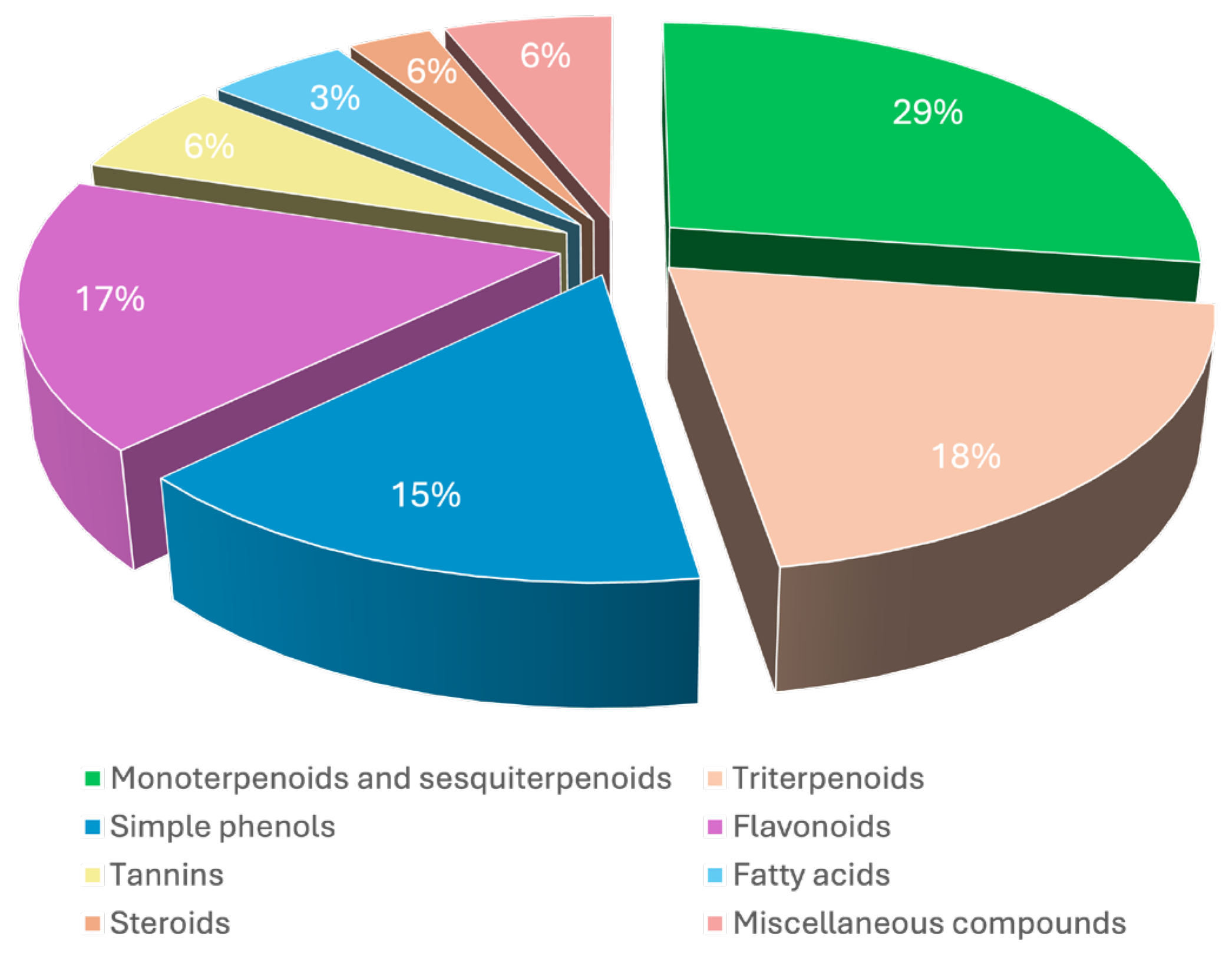
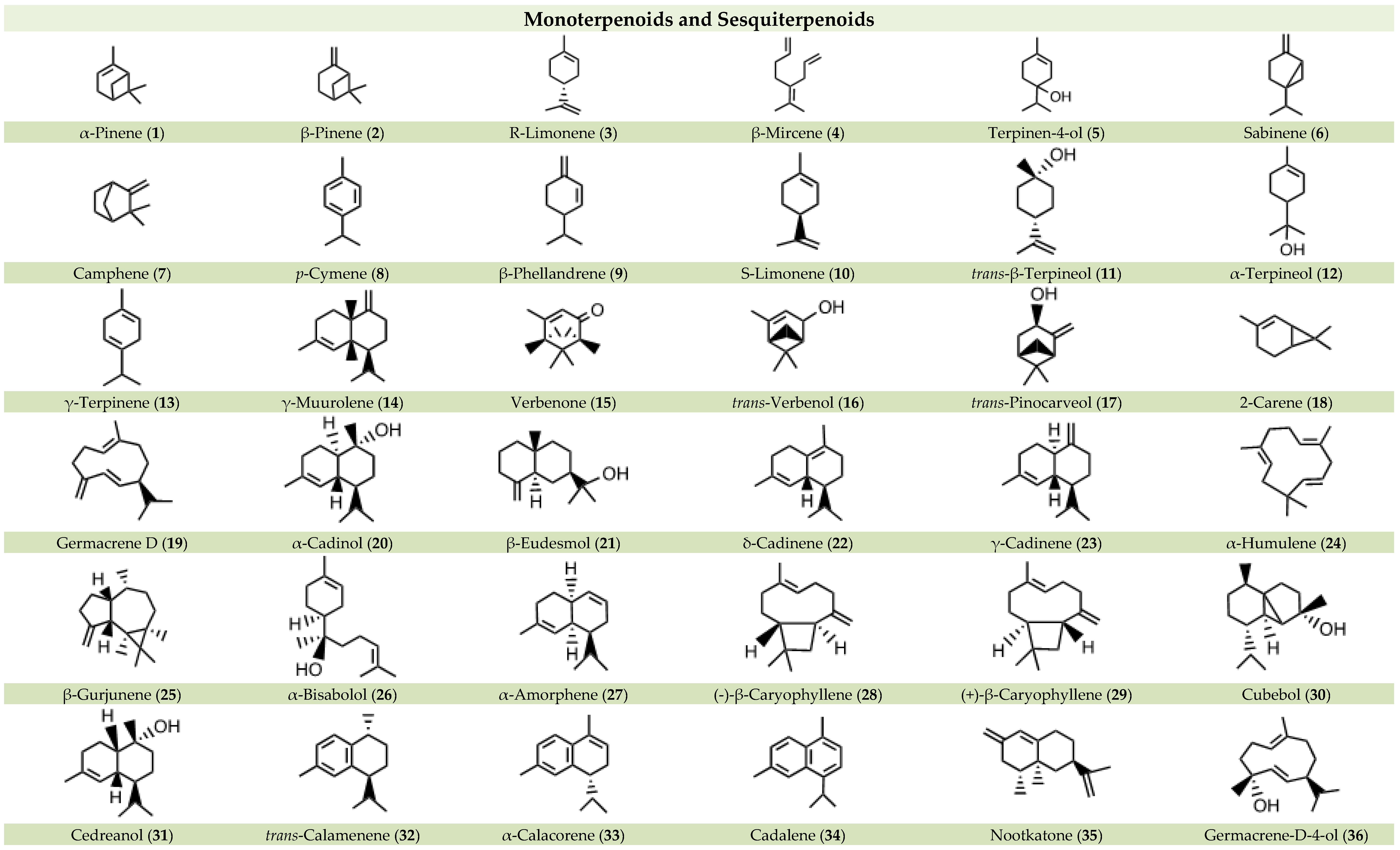
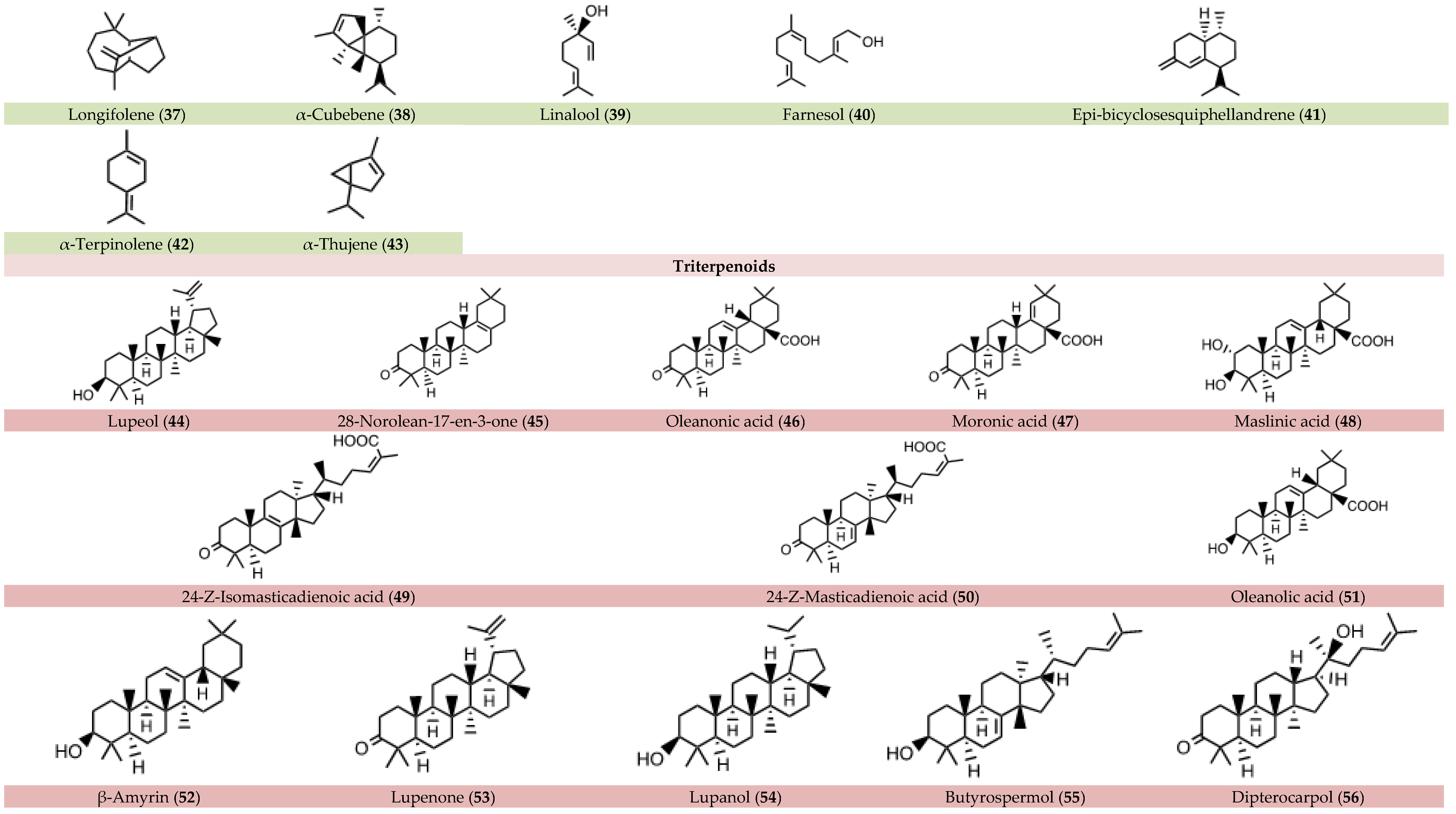

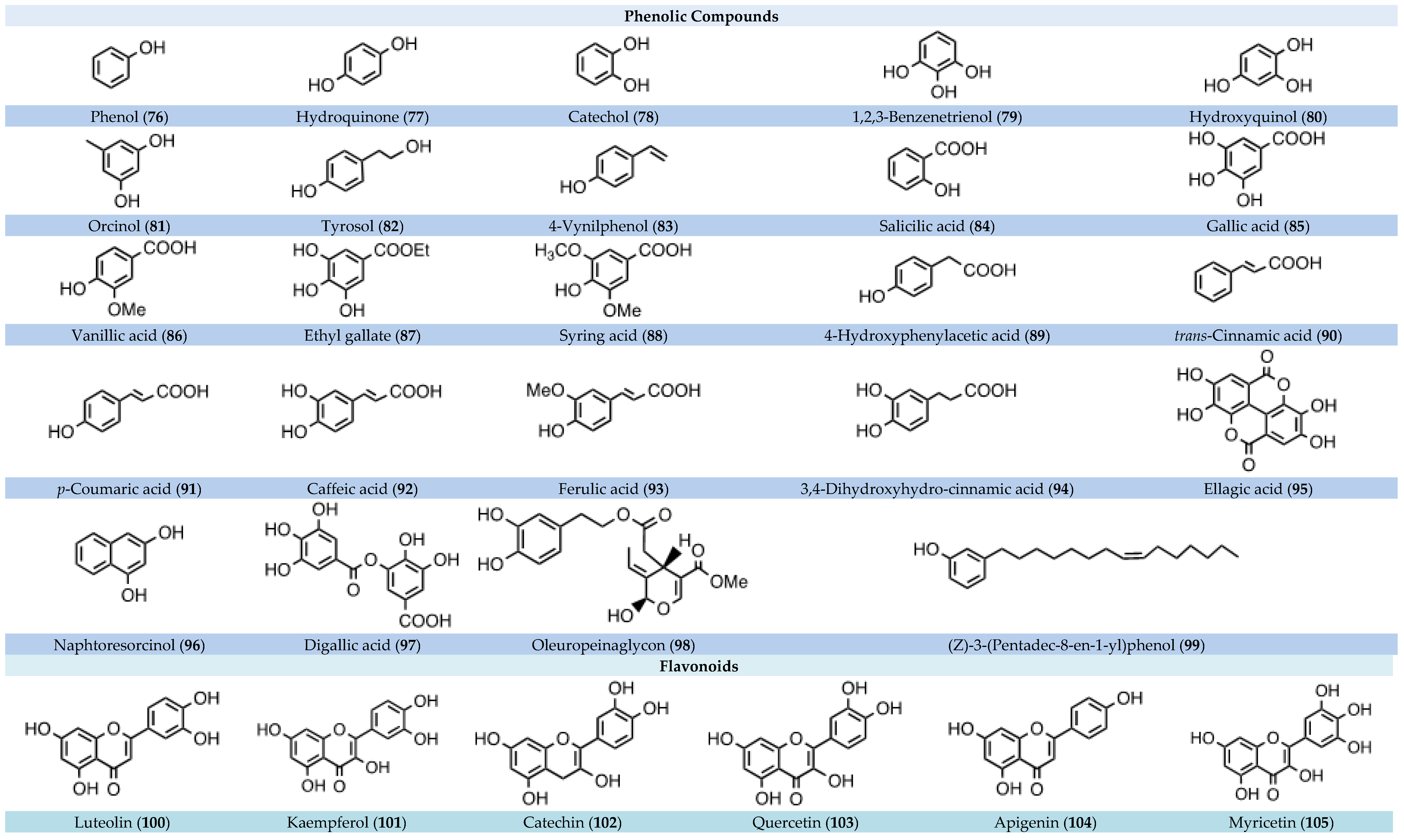
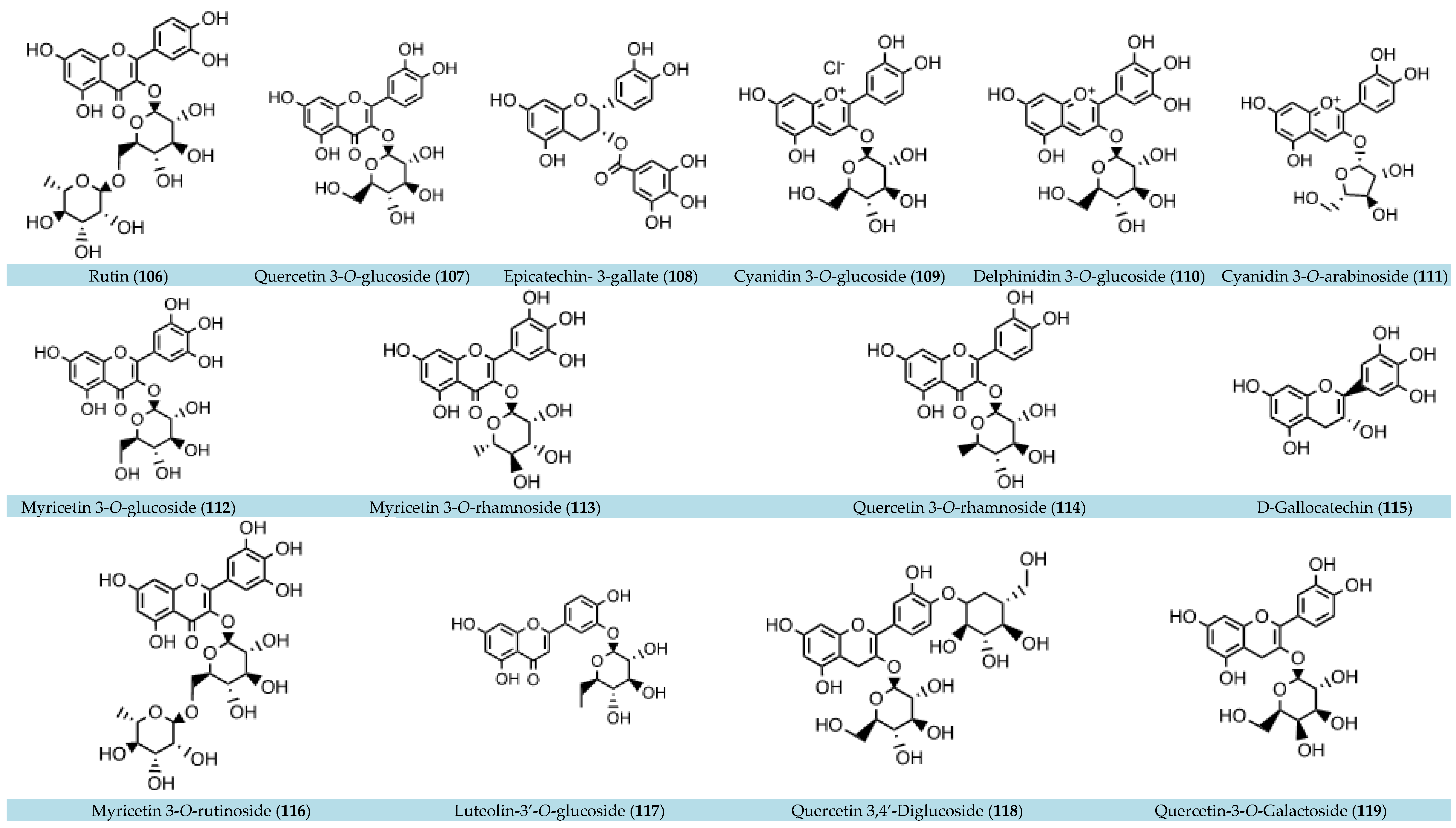
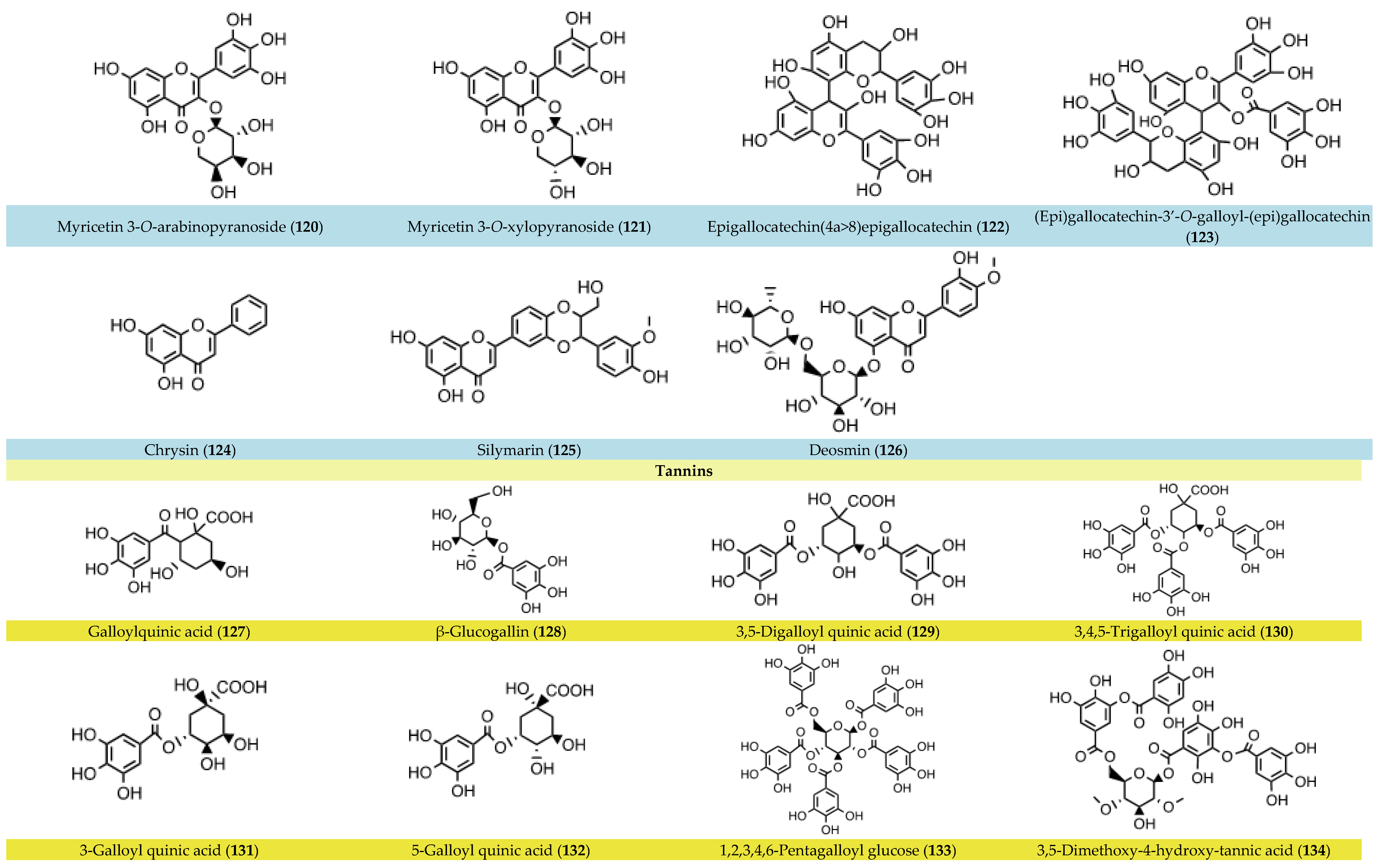


Disclaimer/Publisher’s Note: The statements, opinions and data contained in all publications are solely those of the individual author(s) and contributor(s) and not of MDPI and/or the editor(s). MDPI and/or the editor(s) disclaim responsibility for any injury to people or property resulting from any ideas, methods, instructions or products referred to in the content. |
© 2024 by the authors. Licensee MDPI, Basel, Switzerland. This article is an open access article distributed under the terms and conditions of the Creative Commons Attribution (CC BY) license (https://creativecommons.org/licenses/by/4.0/).
Share and Cite
Floris, S.; Di Petrillo, A.; Pintus, F.; Delogu, G.L. Pistacia lentiscus: Phytochemistry and Antidiabetic Properties. Nutrients 2024, 16, 1638. https://doi.org/10.3390/nu16111638
Floris S, Di Petrillo A, Pintus F, Delogu GL. Pistacia lentiscus: Phytochemistry and Antidiabetic Properties. Nutrients. 2024; 16(11):1638. https://doi.org/10.3390/nu16111638
Chicago/Turabian StyleFloris, Sonia, Amalia Di Petrillo, Francesca Pintus, and Giovanna Lucia Delogu. 2024. "Pistacia lentiscus: Phytochemistry and Antidiabetic Properties" Nutrients 16, no. 11: 1638. https://doi.org/10.3390/nu16111638
APA StyleFloris, S., Di Petrillo, A., Pintus, F., & Delogu, G. L. (2024). Pistacia lentiscus: Phytochemistry and Antidiabetic Properties. Nutrients, 16(11), 1638. https://doi.org/10.3390/nu16111638







